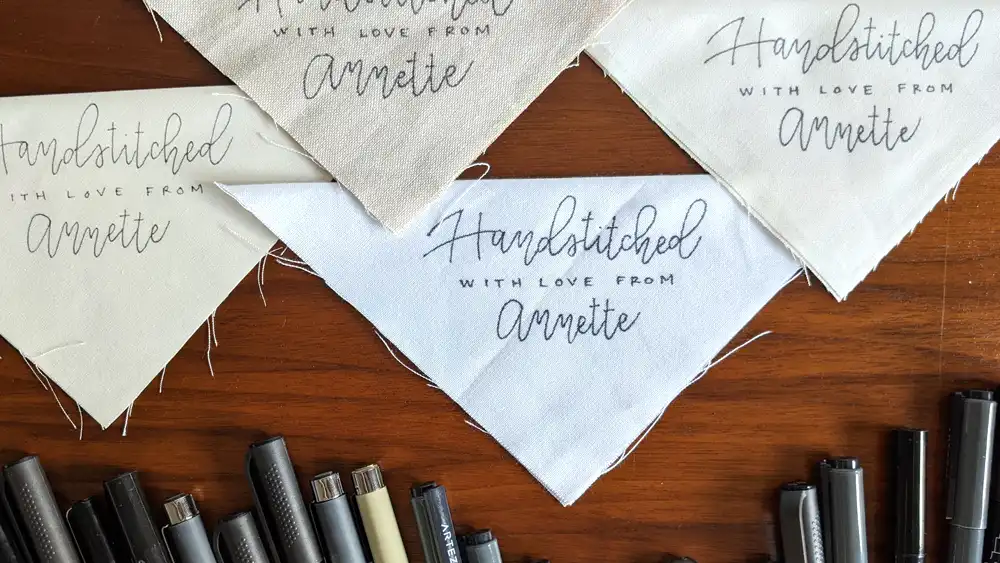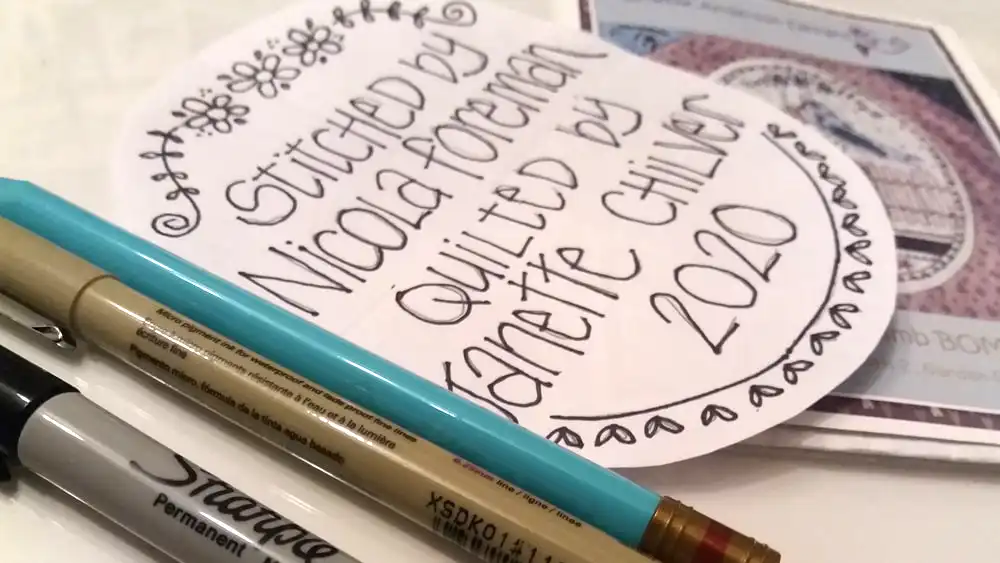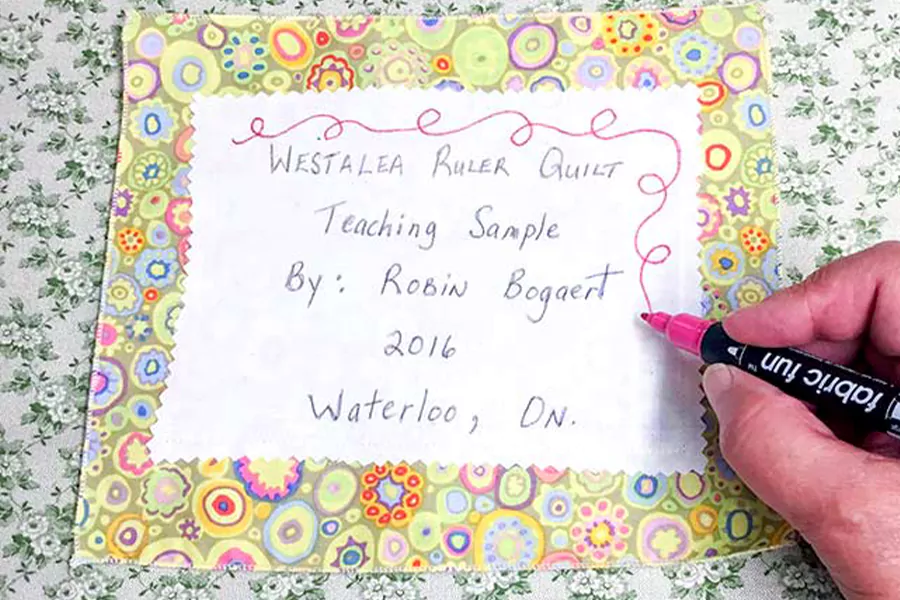Quilting is not just a craft, it’s an art form that allows individuals to express their creativity through the fabric. Whether you’re a beginner or an experienced quilter, knowing how to write on fabric can elevate your projects to new heights.
In this comprehensive guide, we’ll delve into the intricacies of writing on fabric for quilting, covering everything from materials and techniques to tips and tricks for success.
How to Write on Fabric for Quilting?

Quilting is an age-old tradition cherished by many, offering a canvas for creativity and expression. Within this craft lies a unique opportunity to personalize creations through the art of writing on fabric.
Whether you’re a novice or a seasoned quilter, mastering the skill of writing on fabric can add depth and sentiment to your projects.
The Way to Write on The Quilting
When it comes to writing on fabric for quilting, there are several techniques and methods to consider. Each approach offers its own unique advantages and challenges, allowing quilters to choose the method that best suits their project and personal preferences.
Hand Embroidery
Hand embroidery is a classic technique that involves stitching text or designs onto fabric by hand. This method offers quilters complete control over the final outcome and allows for intricate detailing and embellishments.
Fabric Markers and Pens
Fabric markers and pens are another popular option for writing on fabric. These markers are specially designed to adhere to fabric surfaces and come in a variety of colors and tip sizes, making them ideal for adding text and designs to quilting projects.
Free-Motion Quilting
Free-motion quilting involves using a sewing machine to stitch text or designs onto fabric freehand. This method allows for greater speed and precision compared to hand embroidery, making it ideal for larger projects or when time is of the essence.
Stenciling
Stenciling is a versatile technique that involves using pre-made stencils to trace text or designs onto fabric surfaces. This method is perfect for quilters who want to achieve consistent and professional-looking results without the need for advanced embroidery skills.
How to Write on Fabric for Quilting

Writing on fabric for quilting is a skill that allows quilters to add personalized touches to their projects, whether it’s labeling a quilt, adding meaningful quotes, or incorporating intricate designs. Mastering this technique opens up a world of creative possibilities and enhances the storytelling aspect of quilting.
Here’s a step-by-step guide to writing on fabric for quilting:
- Choose the Right Fabric: Start by selecting a fabric that is suitable for writing on. Look for fabrics with a tight weave and smooth surface, as these will provide the best results. Cotton fabrics are a popular choice for quilting and work well for writing on.
- Prep the Fabric: Before writing on the fabric, it’s essential to prepare it properly. Wash and press the fabric to remove any dirt, oils, or sizing that may interfere with the writing process. Ensure the fabric is smooth and free from wrinkles before proceeding.
- Select Your Writing Tool: There are several options for writing on fabric, including fabric markers, pens, pencils, and even embroidery floss for hand embroidery. Choose a tool that is suitable for your project and desired outcome. Test the tool on a scrap piece of fabric to ensure it produces the desired results.
- Plan Your Design: Before writing on the fabric, plan out your design or text. Consider the size, placement, and style of writing you want to achieve. You can sketch out your design on paper or use stencils to help guide your writing on the fabric.
- Write on the Fabric: Once you have your design planned out, it’s time to write on the fabric. Use light pressure and steady strokes to write or draw on the fabric, ensuring that the ink or markings are applied evenly and consistently. Take your time and work carefully to avoid smudges or mistakes.
- Allow the Ink to Dry: After writing on the fabric, allow the ink or markings to dry completely before handling or working with the fabric further. Follow the manufacturer’s instructions for drying times, as some inks may require heat-setting or additional curing time.
- Optional: Heat-Set the Ink: If using fabric markers or pens, consider heat-setting the ink to ensure it is permanent and washable. Place a pressing cloth over the written area and press with a hot iron according to the manufacturer’s instructions. This helps to set the ink and prevent it from fading or washing out over time.
- Incorporate into Your Quilt: Once the ink is dry and set, you can incorporate the fabric into your quilting project as desired. Whether it’s adding labeled blocks, stitching over written designs, or quilting around written text, have fun experimenting with different ways to incorporate your writing into your quilt.
By following these steps, you can master the art of writing on fabric for quilting and add a personalized touch to your quilting projects that will be cherished for years to come.
Problems You May Encounter When Writing on Quilted Fabric
Fabric Bleeding
One common issue that quilters may encounter when writing on fabric is bleeding. This occurs when the ink or dye used to write on the fabric spreads beyond its intended boundaries, resulting in blurred or distorted text and designs.
Fading Over Time
Another challenge of writing on fabric is the potential for fading over time. Exposure to sunlight, washing, and general wear and tear can cause the ink or dye to fade, making it essential to choose high-quality materials and techniques that offer long-lasting results.
Smudging and Smearing
Smudging and smearing can occur when the ink or dye used to write on fabric does not properly adhere to the fabric surface. This can result in messy-looking text and designs that detract from the overall appearance of the quilt.
Causes and Risk Factors
Poor Quality Materials
Using low-quality fabric, ink, or markers can increase the risk of bleeding, fading, and smudging when writing on fabric. Investing in high-quality materials is essential for achieving professional-looking results that stand the test of time.
Incorrect Technique
Using the wrong technique when writing on fabric can also contribute to issues such as bleeding, fading, and smudging. It’s essential to follow best practices and guidelines for the chosen method to ensure optimal results.
Environmental Factors
Environmental factors such as humidity, temperature, and sunlight exposure can also impact the longevity and appearance of writing on fabric. Storing quilts in a cool, dry place away from direct sunlight can help preserve the integrity of the text and designs over time.
How to Avoid These Problems

Diagnosing issues with writing on fabric for quilting often requires a hands-on approach. By carefully examining the fabric and observing how the ink or dye behaves, quilters can identify potential problems and determine the best course of action for remedying them.
Visual Inspection
A visual inspection of the fabric surface can reveal signs of bleeding, fading, smudging, or other issues associated with writing on fabric. Quilters should closely examine the text and designs to identify any areas that may require touch-ups or repairs.
Test Swatches
Creating test swatches using different materials, techniques, and environmental conditions can help quilters determine the optimal approach for writing on fabric. By comparing the results of these test swatches, quilters can fine-tune their methods and achieve the desired outcomes.
Treatment Options
Once issues with writing on fabric for quilting have been diagnosed, there are several treatment options available to address them. From simple touch-ups to more extensive repairs, quilters can choose the approach that best suits their needs and the specific requirements of their project.
Spot Cleaning The Quilting Fabric
For minor issues such as smudges or small areas of bleeding, spot cleaning with a gentle detergent or stain remover may be sufficient to restore the fabric to its original condition. Quilters should take care to test any cleaning products on a small, inconspicuous area of the fabric first to ensure compatibility and avoid further damage.
Color Correction
In cases where the ink or dye has faded or changed color over time, color correction techniques can be used to restore the fabric to its original appearance. This may involve carefully matching and applying additional ink or dye to the affected areas to achieve a seamless blend with the surrounding fabric.
Patching and Repair
For more extensive issues such as large areas of bleeding or damage, patching, and repair may be necessary to salvage the quilt. This can involve cutting out the affected sections of fabric and replacing them with new pieces, or using techniques such as appliqué or embroidery to cover up the damage.
Preventive Measures
Preventing issues with writing on fabric for quilting is often easier than addressing them after the fact. By taking proactive steps to minimize risk factors and protect the integrity of the fabric, quilters can ensure that their projects stand the test of time.
Choose High-Quality Materials
Selecting high-quality fabric, ink, and markers is essential for achieving professional-looking results that resist bleeding, fading, and smudging. Opt for fabrics that are specifically designed for writing on, and choose ink or markers that are labeled as permanent and fade-resistant.
Test The Quilting Fabric Before Applying
Before writing on the fabric for your quilting project, it’s crucial to perform a test on a small, inconspicuous area of the fabric. This allows you to assess how the ink or dye interacts with the fabric and provides an opportunity to make any necessary adjustments to your technique or materials.
Store Quilts Properly
After completing your quilting project, it’s essential to store your quilt properly to protect it from environmental factors that can affect the integrity of the writing on the fabric. Store quilts in a cool, dry place away from direct sunlight to prevent fading and discoloration over time.
Conclusion
Writing on fabric for quilting is a skill that can enhance the beauty and storytelling of your quilting projects. By understanding the various techniques, materials, and challenges associated with writing on fabric, quilters can create stunning works of art that are truly one-of-a-kind.
Whether you’re adding personal touches to commemorate special occasions or incorporating meaningful quotes into your designs, writing on fabric opens up a world of creative possibilities for quilters of all skill levels. With the right materials, techniques, and a little bit of experimentation, you can master the art of writing on fabric and take your quilting projects to new heights.
Remember to choose high-quality materials, test before applying, and store your quilts properly to ensure that your writing on fabric remains vibrant and beautiful for years to come.
